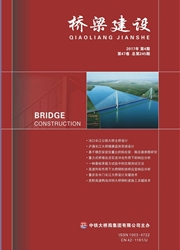

 中文摘要:
中文摘要:
提出公路钢桥细节精细化抗疲劳设计方法,通过整体结构活载分析确定全桥疲劳关键部位,综合交通量调查及国外相关规范选取等效疲劳车进行移动荷载时程分析,确定关键部位构件的内力幅,建立关键部位局部分析模型进行热点应力幅分析,然后根据特定类型细节构造的S~N曲线计算其疲劳寿命,最后结合设计年限内交通量状况对结构抗疲劳能力进行评估。天津海河国泰桥抗疲劳设计评定的算例分析表明,本方法思路清晰,计算简单,便于工程设计人员掌握;参考不同的国外规范进行设计,其疲劳安全性相差不大,AASHTO标准略为保守。
 英文摘要:
英文摘要:
A refined methodology for anti-fatigue design of highway steel bridge details is proposed. Firstly, the critical locations of the whole bridge that are apt to suffer fatigue failure are ascertained by the analysis of the whole structure under live load. On the basis of the comprehensive investigation of traffic volume and with reference to the provisions in the relevant foreign codes, the equivalent fatigue vehicles are selected and the time history analysis of moving load is conducted to obtain the internal force amplitude of elements of the critical locations. Then, the local analysis model for the locations is established to analyze the hot spot stress amplitude and to calculate the fatigue life of the locations in accordance with the S-N curves of special details of the structure. Finally, the fatigue performance of the structure is assessed in consideration of the traffic volume in the designed years. The analysis of the numerical example of the fatigue design and assessment of the Guotai Bridge over the Haihe River in Tianjin indicates that the consideration of the methodology provided in the paper is clear, the calculation is simple and is convenient for designers to use. The anti-fatigue design is made with reference to the different foreign codes, the differences of the fatigue safety are not great, however, the AASHTO is deemed a littlie conservative.
 同期刊论文项目
同期刊论文项目
 同项目期刊论文
同项目期刊论文
 期刊信息
期刊信息
